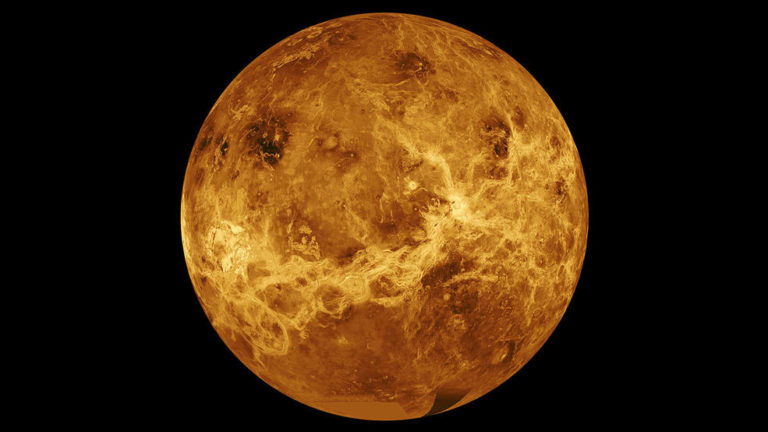What has a volcanic rock surface hot enough to melt lead, an atmosphere so thick that the sun is just a smidgin of light, a body that spins backwards, and is under tremendous pressure? Is the first thing you think of – love? It is our sister, and second plant from the sun – Venus, named after the Roman goddess of love.
The Ancient Egyptians and Greeks could easily see Venus and thought it was two separate bodies, giving them the names The Morning Star and The Evening Star – until the Ancient Romans came along. This is because Venus can be seen at night, and again in the morning as the brightest star in the sky, after the sun and the moon. The Ancient Romans could easily see seven bright objects in the sky – the sun, moon, Mercury, Venus, Mars, Jupiter and Saturn, and named them after their most important gods.

Venus is a sight that is pretty hard to miss, it is the brightest star lighting up our chilly Perth nights, and if you dare to make an early appearance outside, maybe to put your bin out, you will see its brightness back in the sky. How brilliant is it to know this is the same star that filled the mornings and nights of the Egyptians as they collected water from the Nile, as Roman philosophers discussed ideas as they took their evening walks in their gardens, and as Isaac Newton spent hours deep in thought studying the skies.
Venus could be compared to a painting by Claude Monet, from a distance it looks like a magnificent creation but you get a close up you may not be quite sure of what you are looking at. Venus has an atmosphere filled with carbon dioxide, shrouded in thick yellow sulphuric clouds that trap heat. Crushing air pressure is similar to the pressure 1609 meters below the ocean on Earth, and winds measured as high as 360 kilometres per hour whip the planet at the top of the clouds. Also, Scientists who study Astrobiology are trying to find explanations to the persistent dark streaks found at the top of Venus’ clouds; they have this habit of absorbing ultraviolet radiation.
On those sweltering hot Perth days, when you come out of your air-conditioning house and that hot dry air completely dries up your lungs, nose and mouth, and you need 50 SPF on to check your mail box because it’s nearly 35 degrees by nine in the morning? Venus surface temperatures are over 15 x higher at around 475 C. According to NASA, did you know Venus is hotter then Mercury, which is the 1st planet from the sun!!
Venus has a similar sized iron-core, but it doesn’t have its own magnetic field internally, it has an induced magnetic field. This is a weak magnetic field created by the interaction of the sun’s magnetic field and Venus’ outer atmosphere. Ultraviolet light from the sun excited the gases -ions – in the outermost atmosphere, and this region is called the ionosphere. The solar wind, which is this 1,609,000 million km gale wind of electrically charged particles, carries the sun’s magnetic field. When the sun’s magnetic field interacts with the electrically excited ionosphere on Venus, it induces or creates the magnetic field there. This field envelopes the planet like a warm hug, and is shaped like the tail of a comet as these gale winds blow past Venus, and continue to Earth where they create the beautiful Southern and Northern lights.
Skip to 2:15
Curious about where Venus is right this very minute? Visit the following NASA link to find out. https://solarsystem.nasa.gov/planets/venus/overview/ You can use this link to check where any planet and moon is in real time, and can move the mouse around for a 360 degree view.
On May 21st, 2010, an orbiter called Akatsuki was launched from the space centre in Japan, with the goal of studying weather patterns on Venus, to search for signs of active volcanism and confirm the presence of lighting in the thick clouds. Like many Kwinana Fwy drivers, Akatsuki missed the turn off to Venus and orbited the sun for five years due to a refusal to stop and ask for directions, and arrived in the Venus orbit on December 7th, 2015.
Meteorological information was gathered by globally mapping Venus’ clouds with five cameras; one ultraviolet, three infrared wavelengths and one in invisible light. The five cameras are very sensitive to different depths in the atmosphere, from Venus’ cloud tops, down to the surface. Akatsuki was also carrying a ‘radio occultation’ experiment where a radio beam is fired straight through to Venus’ atmosphere, then back to a station on earth. Measuring these changes allows Scientists access to all those thick layers of the sulphuric clouds.
Three hours after the arrival on Venus, Akatsuki was welcomed with a bow in the shape of a gravity wave, (Not a gravitation wave as we have here on earth.). This happens when two different fluids, each with different densities, meet at an interface. These waves form at this interface as the force of gravity is acting to restore the equilibrium in a whole system. This phenomenon is common on Earth; however, no gravity waves on this scale can be found on our earth. Astronomers propose that this gravity wave may have been caused by mountain ranges on the surface that are pushing the dense lower atmosphere to higher altitudes where gases are less dense. It is still a mystery to the space station on how this gravity bow wave formed, and as usual, space exploration continues.

Photo source: NASA
But besides the acid clouds with unidentified black streaks, temperatures that could melt lead, crushing pressure, and an axis that spins the planet backwards, no moons and nobody has put a ring on it – there are some beautiful landscapes about this planet. A landscape peppered with tectonic forces, massive eruptions, a buckling surface with beautiful valleys, high mountains and thousands of volcanoes which Scientists believe are still active.
There is a rocky highland area the size of Australia called Ishtar terra near the north pole, and a South-American size area called Aphrodite Terra that stretches across the equator. A mountain rises to 36,000 feet, which is higher than Mt Everest. If you are ever in the area, you might like to stop by Sacajawea, a volcanic crater named after Lewis and Clark’s Native American guide, and if you have time, stroll through Diana, a deep canyon named after the Roman goddess of the hunt. And the best part is that you can view all this in the colours red and orange.

Photo source: NASA
So it’s not the rugged red outback of Northern Territory, or the spectacular red/pink/orange bursting sunsets of Western Australia, or an Alaskan wilderness with bears in the background catching red salmon. But it is out of this world!
Between now and December get outside, go hiking and view the bright star in the sky that the ancient people watched night and morning, knowing what you now know about this second planet from the sun in all of its red and orange glory. Look out for my new series that will be posted in the first few days of every month that will tell you what to look for in the sky.
Use this link to visit the time and date website to find out times to view the planets, moons, sunrise/set and much more. https://www.timeanddate.com/astronomy/night/australia/perth















